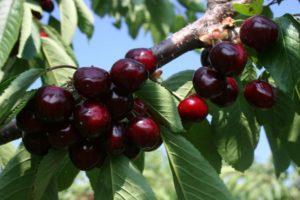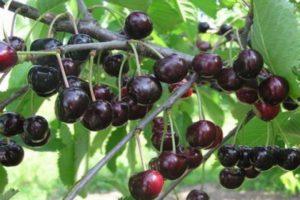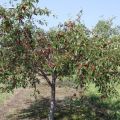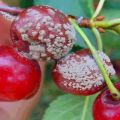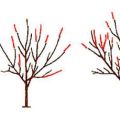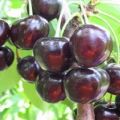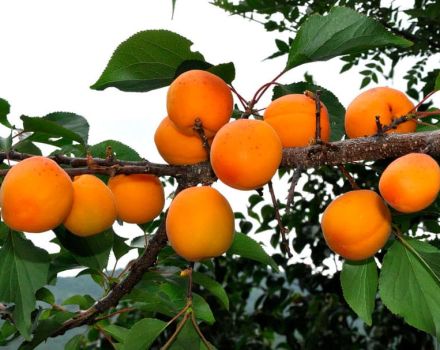Description and characteristics of the Leningradskaya black cherry variety, cultivation and care
Modern selection offers a large number of different varieties of sweet cherries, each of which has its own merits. Gardeners in the middle zone, where winters are cold and frosts are strong enough, should pay attention to the Leningrad black cherry. This variety has high frost resistance, but at the same time it gives a stable yield of tasty fruits.
Characteristics and description of the Leningradskaya black cherry variety
Cherry variety Leningradskaya Black was bred for cultivation in the northwestern part of Russia. The efforts of breeders were aimed at creating more hardy plants, increasing their winter hardiness, accelerating the ripening of fruits.
Description of the Leningradskaya black cherry variety includes the following characteristics:
- the height of the tree does not exceed 4 m;
- branches and shoots, covered with oval green leaves with a serrated edge, are characterized by rapid growth;
- the crown is formed wide and spreading;
- brownish-brown bark has a soft structure;
- white flowers bloom in the second half of May, collected in small inflorescences.
With proper care, the trees give a harvest in the 2nd year, by the 5th year of life, it is 35 kg per plant. Tasters rate the taste of these berries at 4.2 on a five-point scale. Characteristics of the fruits of this variety:
- heart-shaped;
- berry weight 3-4 g;
- cherry, almost black skin color;
- sweet and sour taste;
- juicy pulp with a fibrous structure;
- small bone;
- spicy aroma.
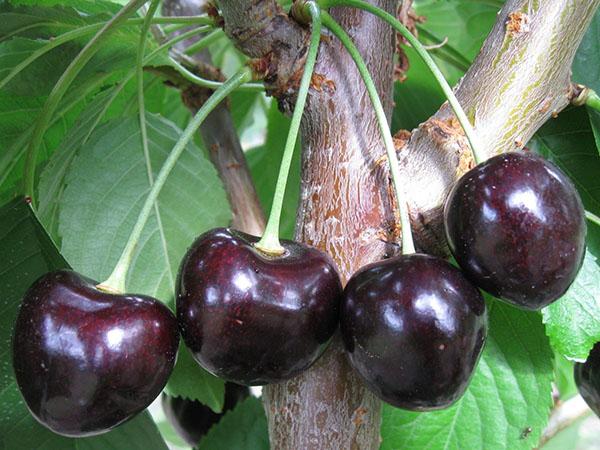
Advantages and disadvantages of the variety
Advantages of the Leningradskaya black cherry variety:
- resistance to low temperatures;
- stable above average yield;
- pleasant fruit taste;
- fast ripening;
- strong immunity;
- possibility of long-term transportation without loss of presentation.
Among the disadvantages are:
- self-infertility;
- the need for watering;
- uneven ripening of berries;
- average berry size.

Nuances of growing a tree
The main feature of the Leningrad black cherry is its self-fertility. To form the ovary, it is necessary to plant a pollinator next to it, which is usually used as another variety of sweet cherries. Conditions for successful pollination:
- coincidence of the flowering period;
- the distance between trees is not more than 3 m;
- persistently warm weather;
- no lingering rains or prolonged drought.
To save space in the garden, you can plant cherry varieties suitable for cross-pollination on one rootstock.

Cherry varieties recommended as pollinators for Leningradskaya black:
- Leningrad yellow or pink;
- Jealous;
- Michurinka;
- Iput;
- Bryanochka;
- Teremoshka;
- Tyutchevka;
- Seda.
Landing time and place
Cherry variety Leningradskaya Black was bred for cultivation in cold climates. Saplings will take root best if they are planted in early spring, before the growing season. In warm climates, autumn planting is recommended when the growing season is over and the plants have already dropped their foliage.

For the cultivation of the Leningrad black cherry and pollinator varieties, a place with suitable conditions is chosen:
- abundant lighting;
- the surface of the site is flat or with a slight slope;
- reliable protection from blowing winds;
- the distance to the nearest trees is at least 3 m;
- groundwater is not higher than 2 m from the surface;
- acidity in the range of 6.5-7.0 pH;
- loose loamy or sandy loam soils.
Seedling preparation
It is recommended to buy seedlings from reliable nurseries and garden centers. Their age should be 1-2 years, and a height of about 1 m.Before planting, the seedling must be examined and carefully prepared:
- The trunk and shoots must not be damaged or moldy.
- The seedling must have a central guide and several lateral shoots.
- Dry twigs are removed.
- At low moisture content, the roots are soaked in water for several hours.
- To enhance the subsequent growth of the roots, a small amount of the stimulant is dissolved in water.
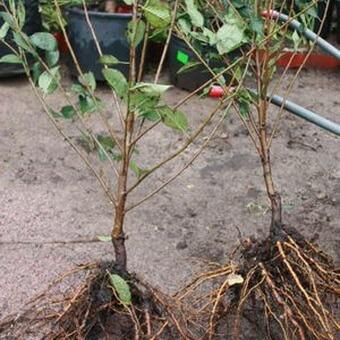
Planting process
The technology of planting cherries of the Leningradskaya Black variety is carried out according to the general rules:
- The landing pit is prepared in advance. In autumn for subsequent spring planting or 3 weeks before planting cherries in the fall. Its depth is 60 cm, and its diameter is 70-100 cm.
- Until the middle, the pit is filled with a nutrient mixture of black soil and humus. 270 g of fertilizers are also added there: 1/3 of potash and 2/3 of phosphate.
- Up to 40 liters of water are poured into the pit.
- The extracted soil is stored until planting begins.
- A third of the soil is poured into the bottom of the pit in a slide.
- The roots of the seedling are evenly laid out on the slopes of the hill and covered with earth, holding the tree upright. In this case, the neck should remain about 5 cm above the surface.
- The soil is compacted.
- Water the seedling with 20 liters of warm water.
- The trunk circle is mulched with crushed peat.

The subtleties of plant care
It is not difficult to take care of the Leningrad black cherry, it is enough to follow the watering rules, prune the crown in a timely manner and add the necessary nutrients to the soil.
Watering rules
Leningrad black cherry belongs to moisture-loving varieties, and it must be watered several times per season:
- The first irrigation is carried out in the spring before flowering. 1 tree needs 40 liters of warm water.
- In summer, the tree is watered in dry weather, checking the soil moisture at a level of 40 cm from the surface.
- The last time moisture is necessarily brought in in the fall when preparing the plant for winter. For a tree over 5 years old, 100 liters of water is enough. Watering is carried out after digging up the earth and applying fertilizers, but before mulching the trunk circle.
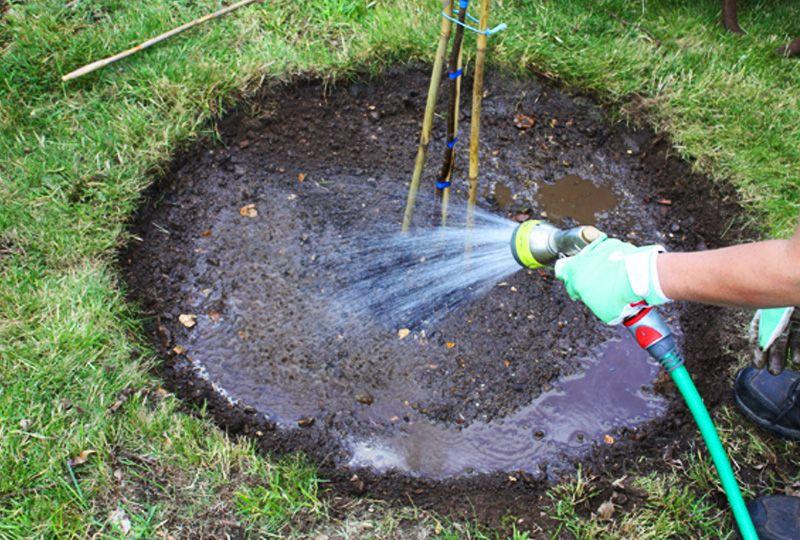
Pruning
The formation and thinning of the cherry crown begins from the first years after planting. Pruning is carried out in early spring, before the juices begin to move. The pruning scheme depends on the age of the plant:
- 1-4 years old. Dry shoots are completely removed, as well as those that grow towards the central conductor or at right angles. The rest are trimmed by 20%, the central one is kept intact.
- 5 years or more. Remove dry and old branches, as well as damaged and diseased shoots.
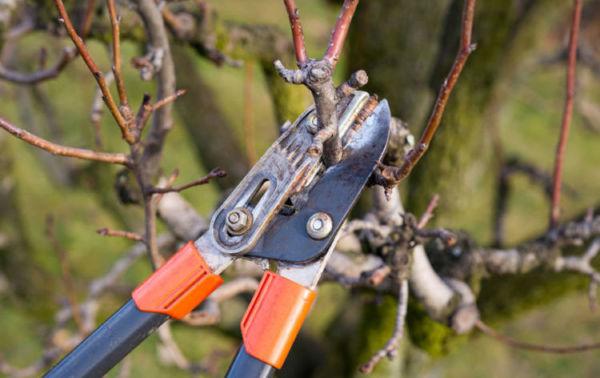
Watering and mulching
For the growth of cherries and a high yield, the soil must maintain moisture. If a soil sample taken at a depth of 40 cm is sticky and crumples well in a lump, then there is no need to water the trees additionally. Stagnant moisture and waterlogging can lead to rotting of the root system and a decrease in the amount of oxygen. Soil mulching is a good substitute for constant irrigation. As a material suitable for this, you can take:
- crushed peat;
- humus;
- needles;
- straw;
- sawdust;
- deciduous litter.

Top dressing
The scheme for applying additional fertilizers is simple, the plant is fed twice a year:
- In May, the soil is enriched with a mixture of urea, potassium sulfate and superphosphate in equal proportions. 60 g of top dressing is enough for one tree.
- After the end of the harvest, cherries are fertilized with superphosphate in a proportion of 50 g per square meter of crown projection.
Every 3 years, the soil under the crown is dug up and mixed with organic fertilizers, which are used as humus from manure or bird droppings.
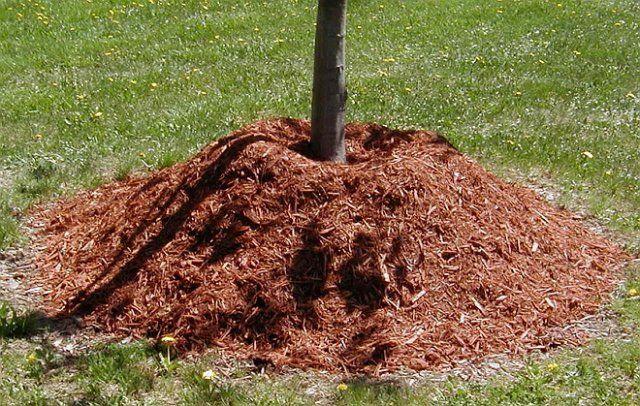
Prevention of diseases, pests and preparation for winter
Despite strong immunity and resistance to many diseases, the Leningradskaya black cherry variety needs preventive measures against such diseases:
- Moniliosis. A 1% solution of Bordeaux mixture will help prevent the appearance of dark spots on the fruit. Spraying of trees is carried out in early spring.
- Gum therapy. The cracks formed on the bark are protected, treated with copper sulphate and covered with garden pitch.
- Clasterosporium disease. The annual spraying of plants with fungicides will help from this disease. It is carried out at the beginning and end of each growing season.
Common fruit pests such as leaf rollers, moths, cherry flies and aphids can be eliminated with modern insecticides.

Preparing cherries for winter includes loosening the tree trunk circle and watering the plant abundantly. To retain moisture in the soil, the entire surface of the earth under the crown is carefully mulched. Young trees for the winter can be wrapped in burlap or special protective fiber. High frost resistance allows the Leningradskaya Black cherry varieties to calmly survive the winter without additional heating measures.
Harvesting and preserving crops
The ripening time of the fruit depends on the growing region. In cold climates, the first berries are harvested in the second half of July, in warm climates much earlier - at the end of June. Cherries ripen gradually, and the harvest can take several weeks. At the same time, the berries hold well on the branches and are not inclined to fall off on their own.
The danger is represented by numerous birds that are not afraid of noise and scarecrows, therefore it is recommended to cover the crown with a special net.
You can store fresh fruits in a refrigerator or basement with a temperature of 2-4 ° C for up to 14 days. Berries perfectly retain their taste and nutrients when frozen. They are suitable for preparations such as compotes, preserves, jam and confiture. Cherry juice can be preserved or frozen.
